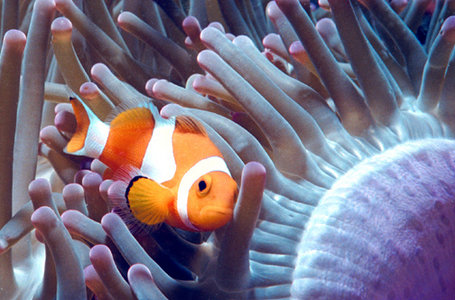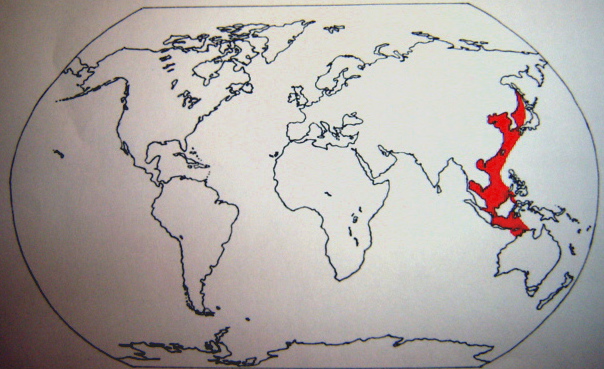What is a Clownfish?
The clownfish is a type of fish that lives in salt water habitats. It is also called an Anemonefish. Clownfish are typically very bright, orange fish that have three white stripes, one at the head, middle and tail. If you look really closely, you may notice that there are thin black lines around the white stripes. Also, the tips of their fins have a thin black rounded stripe.
Clownfish can grow to be from 2 to 5 inches long. The males tend to be significantly smaller than the females. However, there are various types of clownfish that range in colours from blue to yellow.
Clownfish live in a "symbiotic" relationship with certain anemones. This means they benefit from living with the sea anemone, and the sea anemone benefits from the presence of the clownfish. They are the only fish that are able to live in sea anemones and not get stung by their tentacles. Clownfish are very active fish and are extremely aggressive. Because they are quite active, the clownfish are thought to be "clowning around". They defend their territory and the sea anemone that they live in. Clownfish eat the leftovers from fish on the anemone and algae. The leftovers include copepods, isopods and zooplankton.
Clownfish have a few ocean predators, but their greatest threat is humans. People who catch clownfish and keep them as pets in aquariums are making a mistake. There are only ten out of more than one thousand types of anemone that are able to host these fish. Many people put the fish in a tank with the wrong anemone. In captivity, the clownfish can live from 3 to 5 years. In the wild, they live 6 to 10 years.
What is Symbiosis?
Symbiosis describes the special relationship between clownfish and sea anemones. They are the only fish that do not get stung by the tentacles of the sea anemone. Clownfish have a slimy mucus covering that protects them from the sea anemone. However, if this covering is wiped off of a clownfish, it will get stung and possibly be killed when it returns home to the anemone. The clownfish and the sea anemone help each other survive in the ocean. The clownfish, while being provided with food, cleans away fish and algae leftovers from the anemone. In addition, the sea anemones are given better water circulation because the clownfish fan their fins while swimming about.
Where do Clownfish Live?
Clownfish live at the bottom of the sea in sheltered reefs or in shallow lagoons, usually in pairs. Clownfish have a special relationship with the anemone and are very important to them. They are a large help to the anemone as they clean the anemone by eating the algae and other food leftovers on them. They also protect the sea anemones by chasing away polyp-eating fish, such as the butterfly fish.
The map below shows where in the world clownfish can be found. They live in the warmer waters of the Pacific Ocean and Indian Ocean. They are also found in northwest Australia, southeast Asia, Japan and the Indo-Malaysian region. There are no clownfish in the Caribbean.
What is the Life Cycle of the Clownfish?
The spawning season of the clownfish, a time when they breed, is year round in tropical waters. Males attract the females by courting. Courting behaviours include chasing, biting and extending fins. Clownfish lay their eggs in batches on coral, rock or next to the sea anemone that they call home. The male clownfish will build a nest on the rock or coral near the anemone in order to be provided with protection from predators. Breeding starts by the male chasing the female to the nest where the eggs are released. One hundred to one thousand eggs are laid. The male clownfish guards and protects the eggs until they hatch. They hatch within 4 to 5 days.
What are Some Special Characteristics of the Clownfish?
In a group of clownfish, there is a strict hierarchy of dominance. The largest and most aggressive female is found at the top. Only two clownfish, a male and a female, in a group reproduce through external fertilization. The clownfish are hermaphrodites, meaning that they develop into males first, and when they mature, they become females. Also, as mentioned earlier, more than one clownfish is able to live in a sea anemone. If the female clownfish is removed from the group, such as by death, one of the largest and most dominant males would become a female. The rest of the remaining males will move up a rank on the hierarchy.
Summary
- Scientific Name: Amphiprion percula
- Classification:
Kingdom
Animalia
Phylum Chordata Class Actinopterygii Order Perciformes Family Pomacentridae Genus Amphiprion Species Amphiprion percula
- Clownfish are small, brightly coloured fish that live in shallow lagoons or sheltered reefs.
- They are found in the warmer waters of the Pacific Ocean and Indian Ocean. They are also found in northwest Australia, southeast Asia, Japan and the Indo-Malaysian region.
- Clownfish have a symbiotic relationship with sea anemone.
- They can only live in ten out of more than one thousand species of sea anemone.
- Clownfish have a mucus covering that protects them from the sting of the sea anemone's tentacles. This mucus prevents them from being harmed, and allows clownfish to live in sea anemone.
- The diet of the clownfish consists of copepods, algae, isopods and zooplankton.
- Clownfish are hermaphrodites (they develop as males first and mature as breeding females).
Information on the Internet
- Biological Profiles This site provides an in depth analysis of the clownfish with colourful pictures and a helpful map showing where the fish live.
- Clownfish This site has pictures, as well as key facts concerning the clownfish. There is also a "Did You Know?" section.
- Shedd Aquarium: Anemone Clownfish This site includes information about clownfish habitat and biology.
- Fishbase: Orange clownfish A page with clownfish facts.
- Clownfish This site includes a detailed description of the clownfish and their reproductive characteristics.






 Go to quick links
Go to quick search
Go to navigation for this section of the ToL site
Go to detailed links for the ToL site
Go to quick links
Go to quick search
Go to navigation for this section of the ToL site
Go to detailed links for the ToL site